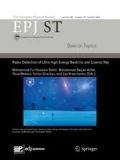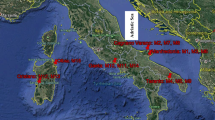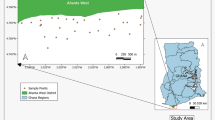Abstract
Artificially produced radionuclides by nuclear reactions are the second type available in the marine environment, in addition to the radionuclides originating from natural sources. Natural radionuclides have been introduced into the environment by several paths of which were unpredictable compared to the anthropogenic activities performed in a controlled manner such as nuclear weapon testing and nuclear fuel reprocessing activities. One major path for radionuclide accumulation to the marine environment from unpredictable sources known to be the river runoffs which transfers the radionuclides deposited over land. In the present study natural—artificial radionuclide activity (226Ra, 232Th, 40K and 137Cs) and trace metal concentrations (Cd, Co, Cr, Ni, Pb, Mn, Fe, Cu, Zn, K, Ca, Mg and Na) in the coastal areas of north-eastern Mediterranean Sea, and the radiological risk to marine biota (fish and invertebrate species) were investigated. Individuals of seven species belonging to two biota groups were analyzed to evaluate the radionuclide activity levels. Highest activity levels of 226Ra, 232Th and 40K were detected for Mullus barbatus (8.6 ± 0.8 Bq kg−1), Charybdis longicollis (5.3 ± 0.4 Bq kg−1) and Pagellus acarne (95.7 ± 6 Bq kg−1) respectively. Highest total dose rate for all evaluated radionuclides was 12.6 nGy h−1. 226Ra and 40K were the two radionuclides with highest contribution to the total dose rate. Our results indicated that there is no radiological risk in the study area. Charybdis longicollis samples were detected to be rich in Mn, Zn and Ca.
Graphical abstract



Similar content being viewed by others
Data Availability Statement
This manuscript has associated data in a data repository. [Authors’ comment: The datasets generated during and/or analyzed during the current study are available from the corresponding author on reasonable request.]
References
M. Belivermis, Ö. Kılıç, Y. Çotuk et al., The effects of physicochemical properties on gamma emitting natural radionuclide levels in the soil profile of Istanbul. Environ Monit Assess 163, 15–26 (2010). https://doi.org/10.1007/s10661-009-0812-1
K. Zielinski. Sources, transport and sinks of radionuclides in marine environments. In: GeoPlanet: Earth and Planetary Sciences. Springer Verlag, pp 189–202 (2018)
N. Yamagata, S. Matsuda, K. Kodaira, Run-off of cæsium-137 and strontium-90 from rivers. Nature 200, 668–669 (1963)
D.P. Calmet, Ocean disposal of radioactive waste. Status report. Int At Energy Agency Bull 31, 47–50 (1989)
Europarl (2009) Shipwrecks containing toxic and nuclear waste in the Mediterranean. https://www.europarl.europa.eu/doceo/document/E-7-2009-5516_EN.html. Accessed 8 May 2021
Europarl (2009) The wreck of the Cunsky. https://www.europarl.europa.eu/doceo/document/E-7-20094864_EN.html. Accessed 8 May 2021
Europarl (2009) Toxic waste found in the Tyrrhenian Sea off the coast of Cetraro (Calabria). https://www.europarl.europa.eu/doceo/document/E-7-2009-4567_EN.html. Accessed 8 May 2021
M.A.R. Dar, A.A. El-Saharty, Some radioactive-elements in the coastal sediments of the Mediterranean Sea. Radiat Prot Dosimetry 153, 361–368 (2013). https://doi.org/10.1093/RPD/NCS104
F.P. Carvalho, Radionuclide concentration processes in marine organisms: a comprehensive review. J Environ Radioact 186, 124–130 (2018). https://doi.org/10.1016/J.JENVRAD.2017.11.002
J. Garnier-Laplace, J.P. Baudin, L. Foulquier, Experimental study of 110mAg transfer from sediment to biota in a simplified freshwater ecosystem. Hydrobiologia 235–236, 393–406 (1992). https://doi.org/10.1007/BF00026229
A.A. Ekidin, K.L. Antonov, M.E. Vasyanovich et al., Radioiodine release into the atmosphere during normal operation of nuclear power plants. Radiochem 613(61), 352–364 (2019). https://doi.org/10.1134/S1066362219030111
J.T. Harris, D.W. Miller, Radiological effluents released by U.S. commercial nuclear power plants from 1995–2005. Health Phys 95, 734–743 (2008). https://doi.org/10.1097/01.HP.0000324201.89669.30
J.A. Sanchez-Cabeza, J. Molero, Plutonium, americium and radiocaesium in the marine environment close to the Vandellos I nuclear power plant before decommissioning. J Environ Radioact 51, 211–228 (2000). https://doi.org/10.1016/S0265-931X(00)00018-7
G.F. De Carvalho, J.M. Godoy, Z.L. De Carvalho et al., Tritium (3H) as a tracer for monitoring the dispersion of conservative radionuclides discharged by the Angra dos Reis nuclear power plants in the Piraquara de Fora Bay, Brazil. J Environ Radioact 136, 169–173 (2014). https://doi.org/10.1016/J.JENVRAD.2014.05.022
S.F. Ozmen, Ecological assesment of Akkuyu nuclear power plant site marine sediments in terms of radionuclide and metal accumulation. J Radioanal Nucl Chem 325, 133–145 (2020). https://doi.org/10.1007/s10967-020-07201-w
S. F. Özmen, O. Güven, Sediment Radioactivity Levels of Deep-Water Fishery Grounds in Antalya Bay. Aquat Sci Eng 36:29–33 (2021). https://doi.org/10.26650/ASE2020714512
H. Baltas, M. Sirin, G. Dalgic, U. Cevik, An overview of the ecological half-life of the 137Cs radioisotope and a determination of radioactivity levels in sediment samples after Chernobyl in the Eastern Black Sea, Turkey. J Mar Syst 177, 21–27 (2018). https://doi.org/10.1016/J.JMARSYS.2017.09.005
H.A. Ergül, M. Belivermiş, Ö. Kiliç et al., Natural and artificial radionuclide activity concentrations in surface sediments of Izmit Bay, Turkey. J Environ Radioact 126, 125–132 (2013). https://doi.org/10.1016/J.JENVRAD.2013.07.015
S. Aközcan, Distribution of natural radionuclide concentrations in sediment samples in Didim and Izmir Bay (Aegean Sea-Turkey). J Environ Radioact 112, 60–63 (2012). https://doi.org/10.1016/J.JENVRAD.2012.03.016
H. Baltas, E. Kiris, G. Dalgic, U. Cevik, Distribution of 137Cs in the Mediterranean mussel (Mytilus galloprovincialis) in Eastern Black Sea Coast of Turkey. Mar Pollut Bull 107, 402–407 (2016). https://doi.org/10.1016/J.MARPOLBUL.2016.03.032
Ö. Kılıç, Y. Çotuk, Radioactivity concentrations in sediment and mussel of Bosphorus and Golden Horn. J Radioanal Nucl Chem 289, 627–635 (2011). https://doi.org/10.1007/S10967-011-1140-9/FIGURES/3
S. Topçuoğlu, Monitoring of Radionuclide Concentrations in Marine Algae from the Turkish Black Sea Coast and Bosphorus During the Period of 1984–2001. J Black Sea/Mediterranean Environ 11, 195–204 (2005)
Antalya Governorship (2017) Provincial Directorate of Food, Agriculture and Livestock. Antalya Provincial Agriculture Strategic Plan 2012–2016 (in Turkish). Antalya
D. Tezcan, M. Okyar, Seismic stratigraphy of Late Quaternary deposits on the continental shelf of Antalya Bay, Northeastern Mediterranean. Cont Shelf Res 26, 1595–1616 (2006). https://doi.org/10.1016/j.csr.2006.04.007
P. R. Day, Particle fractionation and particle-size analysis. In: Methods of Soil Analysis, Part 1: Physical and Mineralogical Properties, Including Statistics of Measurement and Sampling. John Wiley & Sons, Ltd, pp 545–567 (1965)
C.A. Black, D.D. Evans, J.L. White et al., Methods of soil analysis: Part 2 (Wiley, 1983)
M. L. Jackson, Soil Chemical Analysis, Edn. 2, Constable & Co. Ltd. London (1967)
U.S. Department of Agriculture (USDA), Agricultural resources: cropland, water and conservation situation and outlook report (AR-Economy Research Service, Washington, D.C., 1987)
B. Kaçar, Toprak Analizleri, 3rd ed. Nobel Akademik Yayıncılık, Ankara (2012)
W.L. Lindsay, W.A. Norvell, Development of a DTPA Soil Test for Zinc, Iron, Manganese, and Copper. Soil Sci Soc Am J 42, 421–428 (1978). https://doi.org/10.2136/sssaj1978.03615995004200030009x
K. Uysal, Y. Emre, E. Köse, The determination of heavy metal accumulation ratios in muscle, skin andgills of some migratory fish species by inductively coupled plasma-optical emission spectrometry (ICP-OES) in Beymelek Lagoon (Antalya/Turkey). Microchem J 90, 67–70 (2008). https://doi.org/10.1016/J.MICROC.2008.03.005
G. Yaprak, M.A.A. Aslani, External dose-rates for natural gamma emitters in soils from an agricultural land in West Anatolia. J Radioanal Nucl Chem 283, 279–287 (2010). https://doi.org/10.1007/s10967-009-0361-7
Resrad-Biyota 1.8 (Argonne National Laboratory, 2003 - 2016), Link: https://resrad.evs.anl.gov/codes/resrad-biota/. Accessed 11 December 2022.
Clement CH (2012) ICRP Publication 119: Compendium of Dose Coefficients based on ICRP Publication 60: Approved by the Commission in October 2011
S. Tekin-Özan, Levels of some heavy metals in water and sediment compared with season and some physico-chemical parameters from Antalya Bay. Indian J Geo-Marine Sci 44, 1393–1400 (2015)
A. Pusceddu, C. Fiordelmondo, P. Polymenakou et al., Effects of bottom trawling on the quantity and biochemical composition of organic matter in coastal marine sediments (Thermaikos Gulf, northwestern Aegean Sea). Cont Shelf Res 25, 2491–2505 (2005). https://doi.org/10.1016/J.CSR.2005.08.013
Stasolla G, Innocenti G, Galil BS (2016) On the diet of the invasive crab Charybdis longicollis Leene, 1938 (Brachyura: Portunidae) in the eastern Mediterranean Sea. Brill 61:130–134. https://doi.org/10.1080/15659801.2015.1123362
Y. Yi, Z. Wang, K. Zhang et al., Sediment pollution and its effect on fish through food chain in the Yangtze River. Int J Sediment Res 23, 338–347 (2008). https://doi.org/10.1016/S1001-6279(09)60005-6
Froese R, Pauly D (2019) FishBase: World Wide Web electronic publication. www.fishbase.org
Nikinmaa M (2014) An Introduction to Aquatic Toxicology. An Introd to Aquat Toxicol 1–240. https://doi.org/10.1016/C2012-0-07948-3
P.S. Rainbow, Trace metal concentrations in aquatic invertebrates: why and so what? Environ Pollut 120, 497–507 (2002). https://doi.org/10.1016/S0269-7491(02)00238-5
Hurtado-Bermúdez S, Valencia JM, Rivera-Silva J, et al (2019) Levels of radionuclide concentrations in benthic invertebrate species from the Balearic Islands, Western Mediterranean, during 2012–2018. Mar Pollut Bull 149:110519. https://doi.org/10.1016/J.MARPOLBUL.2019.110519
Y. Ishikawa, H. Kagaya, K. Saga, Biomagnification of 7Be, 234Th, and 228Ra in marine organisms near the northern Pacific coast of Japan. J Environ Radioact 76, 103–112 (2004). https://doi.org/10.1016/J.JENVRAD.2004.03.021
M. Schnitzer, Significance of soil organic matter in soil formation, transport processes in soils, and in the formation of soil structure. Berichte ueber Landwirtschaft 206, 63–81 (1993)
ICRP (2014) Protection of the environment under different exposure situations
BSGM, 2019. T.C. Tarım ve Orman Bakanlıgı Su Ürünleri İstatistikleri, https://www.tarimorman.gov.tr/sgb/Belgeler/SagMenuVeriler/BSGM.pdf. (Accessed 13 May 2019)
EC, 2019. The EU fish market 2018 edition. https://ec.europa.eu/fisheries/press/eu-fish-market-2018-edition-out_pl. (Accessed 13 May 2019)
UNSCEAR (2006) Report to the General Assembly, with Scientific Annexes. Eff Ioniz Radiat
Acknowledgements
This work was supported by the Scientific Research Project Coordination Division of the Akdeniz University, Grant number BAP, FBA-2019-4449.
Author information
Authors and Affiliations
Contributions
IK: Validation, Formal analysis, Resources, Writing—Original Draft, Visualization. OG: Conceptualization, Methodology, Validation, Investigation, Resources, Data Curation, Writing—Original Draft, Visualization, Project administration, Funding acquisition. FO: ASRI: Resources, Writing—Review & Editing Ozgur AKTAS: Resources, Writing—Review & Editing Ercüment AKSOY: Visualization, Writing—Review & Editing Gunseli YAPRAK: Conceptualization, Methodology, Supervision Ismail BOZTOSUN: Conceptualization, Methodology, Supervision Suleyman Fatih OZMEN: Conceptualization, Methodology, Validation, Formal analysis, Data Curation Resources Investigation, Writing—Original Draft, Visualization, Supervision.
Corresponding author
Ethics declarations
Conflict of interest
The authors have no competing interests to declare that are relevant to the content of this article. The datasets generated during and/or analyzed during the current study are available from the corresponding author on reasonable request.
Supplementary Information
Below is the link to the electronic supplementary material.
Rights and permissions
Springer Nature or its licensor (e.g. a society or other partner) holds exclusive rights to this article under a publishing agreement with the author(s) or other rightsholder(s); author self-archiving of the accepted manuscript version of this article is solely governed by the terms of such publishing agreement and applicable law.
About this article
Cite this article
Koraltan, I., Guven, O., Asri, F.O. et al. An assessment on levels of radionuclides and trace metals and radiological risk to marine biota in the North-Eastern Mediterranean Sea. Eur. Phys. J. Spec. Top. 232, 1583–1593 (2023). https://doi.org/10.1140/epjs/s11734-023-00884-8
Received:
Accepted:
Published:
Issue Date:
DOI: https://doi.org/10.1140/epjs/s11734-023-00884-8




